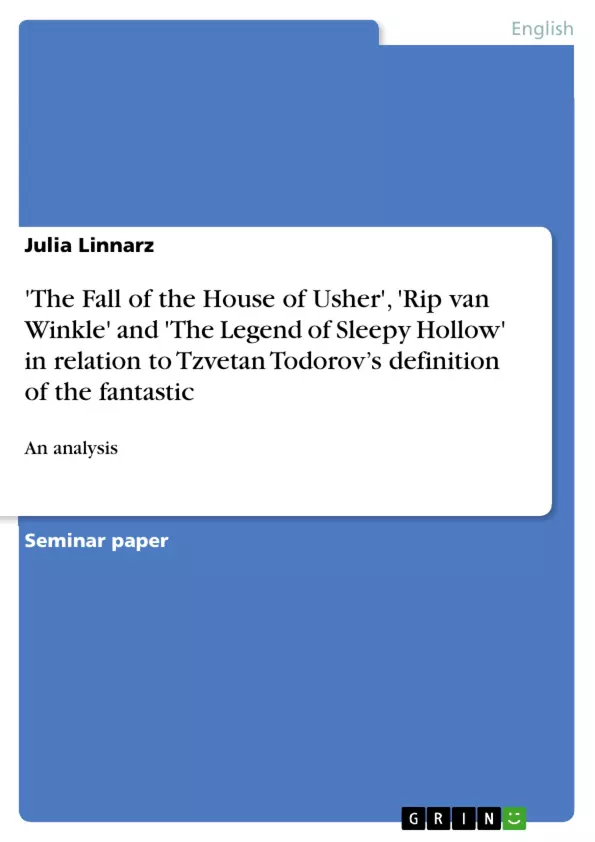Common themes of American Romanticism were sentimentalism, primitivism and the cult of the noble savage, political liberalism, the celebration of natural beauty and the simple life, idealization of the common man and an interest in the picturesque past. Additionally, an interest in the supernatural or in “the crepuscular heart of mystery” (Hart 725) was a widespread topic used by romantic authors. The latter used the supernatural to deal with the disorienting situation of 19th cen-tury American culture, which was not only pressured by the frontier experience but also by an un-ease concerning the experiment of democracy, the virtual nonexistence of a developed American society and racial issues especially relating to slavery and the Native Americans. Additionally, the occupation with the supernatural showed the American romanticists’ concern with the “culture’s occupation with death in an increasingly secular, individualistic, and scientific age”.
Two romantic authors that tried their hand as supernatural tales are Washington Irving and Ed-gar Allan Poe. In their supernatural tales ghosts, ghouls, vampires and other mysterious beings as well as inexplicable phenomena make their appearance. Some of these appearances can be ration-ally explained; others are clearly of supernatural origin. The reader of supernatural tales usually chooses one or the other explanation. However, sometimes the reader hesitates between the two. Stories, in which the latter is the case, are according to Tzvetan Todorov’s definition situated in the fantastic.
In my opinion Washington Irving’s tales Rip van Winkle and The Legend of Sleepy Hollow and Edgar Allan Poe’s The Fall of the House of Usher belong to different literary genres even though they both constitute supernatural stories. The former belong to the fantastic, while the latter does not. This hypothesis will either be proven wrong or right in the course of this paper. To do so, I will first focus on the definition of the fantastic, which is, as mentioned above, given by Tzvetan Todorov in his book The Fantastic: A Structural Approach to a Literary Genre. In a second step I will apply Todorov’s definition to Irving’s and Poe’s tales.
Table of Contents
- The rise of the supernatural tale in American Romanticism
- The literary genres of the fantastic, the uncanny and the marvelous: A definition
- The fantastic
- The uncanny and the marvelous
- Rip van Winkle and The Legend of Sleepy Hollow as fantastic tales?
- Rip van Winkle
- The Legend of Sleepy Hollow
- The Fall of the House of Usher as a tale of the uncanny?
Objectives and Key Themes
This paper analyzes the literary genres of the fantastic, the uncanny, and the marvelous, applying Tzvetan Todorov's definitions to Washington Irving's short stories "Rip van Winkle" and "The Legend of Sleepy Hollow." It examines the nature of supernatural events in these tales and whether they qualify as fantastic, uncanny, or marvelous. The paper seeks to determine which genre these stories belong to, based on Todorov's framework.
- The rise of the supernatural tale in American Romanticism
- The definition of the fantastic, the uncanny, and the marvelous
- The application of Todorov's definition to "Rip van Winkle" and "The Legend of Sleepy Hollow"
- The analysis of "The Fall of the House of Usher" as a tale of the uncanny
- The exploration of sub-genres within the framework of the fantastic, uncanny, and marvelous
Chapter Summaries
- The rise of the supernatural tale in American Romanticism: This chapter examines the context of supernatural tales in American Romanticism, highlighting the shift from colonial dependence to a desire for a distinct American culture. It explores the use of the supernatural as a reflection of the era's cultural anxieties and the desire to break away from European traditions.
- The literary genres of the fantastic, the uncanny and the marvelous: A definition: This chapter introduces Tzvetan Todorov's framework for defining the fantastic, the uncanny, and the marvelous. It explores the key characteristic of the fantastic – the reader's hesitation between believing and disbelieving supernatural events – and contrasts it with the uncanny and the marvelous. It examines how these genres differ in terms of the reader's interpretation and the nature of the supernatural events.
- Rip van Winkle and The Legend of Sleepy Hollow as fantastic tales?: This chapter analyzes Washington Irving's stories "Rip van Winkle" and "The Legend of Sleepy Hollow" in relation to the definition of the fantastic. It explores whether the supernatural events in these tales prompt the reader's hesitation and if they remain within the boundaries of the fantastic genre.
Keywords
The primary focus of this work is on the supernatural tale in American Romanticism, with specific emphasis on the literary genres of the fantastic, the uncanny, and the marvelous. The key concepts explored include Tzvetan Todorov's definition of the fantastic, the role of reader hesitation in genre determination, and the analysis of Washington Irving's short stories "Rip van Winkle" and "The Legend of Sleepy Hollow" in relation to these genres.
- Quote paper
- Julia Linnarz (Author), 2009, 'The Fall of the House of Usher', 'Rip van Winkle' and 'The Legend of Sleepy Hollow' in relation to Tzvetan Todorov’s definition of the fantastic, Munich, GRIN Verlag, https://www.hausarbeiten.de/document/157057


